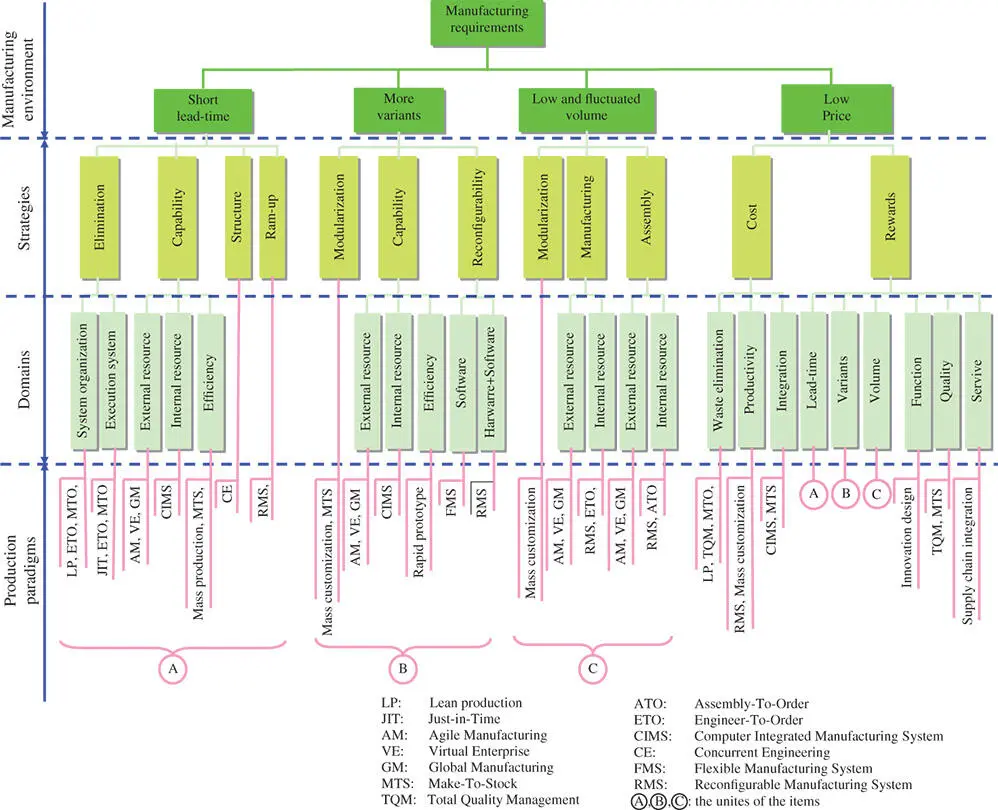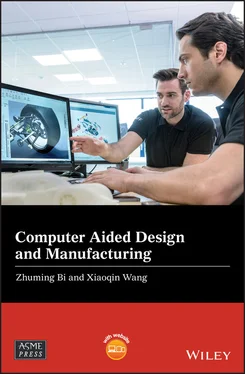1 ...8 9 10 12 13 14 ...30 
Figure 1.5The strategies, domains, and production paradigms of advanced manufacturing technologies (Bi et al. 2008).
The advancement of CATs can be measured by their capabilities in dealing with the growing scales and complexities of systems and the autonomy of system responsiveness. Figure 1.6shows the evolution of CATs from the perspective of these three measures (Bi et al. 2014), together with computer applications in manufacturing using numerical control (NC)/CNC workstations, FMSs, CIM, distributed manufacturing (DM), and predictive manufacturing (PM). Typical computer aided tools to support these enabling technologies are Quality Control (QC), TQM, Enterprise Requirements Planning (ERP‐I), Enterprise Resources Planning (ERP‐II), Product Lifecycle Management (PLM), Software as a Service (SaaS), Platform as a Service (PaaS), and Infrastructure as a Service (IaaS), respectively. Correspondingly, the capacities of software systems to deal with volume, variety, and velocity of the data have been increased gradually from stream data early in the digital era to big data now. IT hardware systems must be capable of processing data in a timely manner. The computing environments have evolved from Microchip, mainframe, servers, the Internet, to today's Cloud.

Figure 1.6Evolution of computer aided technologies in manufacturing (Bi and Cochran 2014).
1.2 Computer Aided Technologies (CATs)
Computer aided technologies provide the aids for design, analysis, manufacture, and assembly of products and for design, planning, scheduling, controlling, and operations of production systems. Various CATs have been gradually known and adopted by engineers since CATs and tools were developed in the late 1950s. Wikiversity (2019) divides the historical development of computer aided design (CAD) into the stages of two‐dimensional, three‐dimensional, and parametric designs. Many other researchers discussed the development of CAD technologies by marking some significant theoretical contribution and products as milestones.
The first system of CATs in manufacturing was developed by Patrick Hanratty in 1957 as a programming system for numerical control. The major innovation in CATs occurred in 1963 when Ivan Sutherland, for his PhD thesis at MIT, created Sketchpad, which was based on a GUI (Graphical User Interface) to generate x – y plots. The innovation in Sketchpad pioneered the use of object‐oriented programming in modern CAD and CAE (Computer Aided Engineering) systems. In the 1960s, the extensive works were developed in the aircraft, automotive, machine control, and electronics industries for three‐dimensional modelling and the programming for numerical control. A few significant works were published as the fundamentals of the CAD theory, such as the mathematical representations of polynomial curves and surfaces by Bezier and Casteljau (Citroen Automotive Company) and Coons at MIT (Ford Motor Company).
Due to the rapid growth of computing power and reduction of hardware sources, three‐dimensional (3D) modelling techniques are now widely used in video games, robotics, simulation of discrete systems, medical imaging and diagnosis, and in computer‐controlled surgeries. As a milestone, the Manufacturing and Consulting Services Inc. (MCS) had developed CAD technologies in their commercially available Automated Drawing and Machining (ADAM) (Cadhistory 2019). The software was used and updated by McDonnell Douglas as Unigraphics and by Computer Vision as CADDs. Later, 3D printing technologies were developed and 3D printing technology evolved from 3D polygonal modelling to some objects with highly curvy surfaces, machine objects, and many other objects. 3D printing gave a boost to the development of computer aided manufacturing (CAM) technologies. As a few examples of successful companies in the CAM fields, (i) 3D Systems Corporation specializes in converting 3D solid or scanned models into physical objects; (ii) Stratasys Ltd. adopts additive manufacturing (AM) for direct manufacture of end parts; (iii) Intuitive Surgical Inc. designs, manufactures, and markets da Vinci surgical systems, as well as related instruments and accessories; and (iv) iRobot Corporation designs, develops, and markets robots for consumer, defence, security, telemedicine, and video collaboration. Caudill and Barnhorn (2018) provided a comprehensive summary of the milestones in the 60‐year development of CATs, which is given in Table 1.1.
Table 1.1Milestones in the 60 year history of CAD development (Computer History 2019a).
| Year |
Products, developers, and features |
| 1957 |
PRONTO was developed by Patrick Hanratty as the first commercial numerical control programming system. It sparked everything that is CAD, known as the building block of everything CAD. |
| 1960 |
Sketchpad was developed by Ivan Sutherland as the first tool with a graphic user interface. Users wrote with a light pen on an x – y pointer display, let users constrain properties in a drawing, and created the use of objects and instances. |
| 1966 |
Computer Aided Design and Drawing (CADD) was developed by McDonell‐Douglas. It was used to create layouts and geometry of designs and could be customized and improved for specific uses. |
| 1967 |
The Product Design Graphics System (PDGS) was developed by Ford and used internally at Ford and its partners as CAD/CAM systems. Digigraphics was developed by Itek as the first commercial CAD system with a unit price of $500 000; only six copies were sold. |
| 1970 |
SynthaVision was developed as the first available commercial solid modelling program. |
| 1971 |
Automated Drafting and Machining (ADAM) was developed by Patrick Hanratty as an interactive graphics design, drafting, and manufacturing system. It was written in Fortran and designed to work on virtually every machine. Today, nearly 80% of CAD programs can be traced back to the roots of ADAM. |
| 1975 |
ComputerVision by Kenneth Versprille was where the rational B‐spline geometry was added to CAD systems. |
| 1977 |
CADAM was used by Lockheed to pioneer the applications of CAD in aerospace engineering. |
| 1978 |
Unigraphics was developed by Siemens as a high‐end and easy to use software; it was used by many corporations and set a new gold standard for CAD software at that time. |
| 1980 |
MiniCAD was introduced as the bestselling CAD software on Mac computers. |
| 1981 |
Geometric Models (GEOMODs) were developed and featured geometric precision and accuracy due to the modelling capability using a non‐uniform rational B‐spline (NURBS). |
| 1982 |
AutoCAD was developed by Autodesk as the first CAD software made for Personal Computers (PCs) instead of mainframe computer workstations. |
| 1987 |
Pro/Engineer was developed as the first mainstream CAD tool incorporating the ideas of Sketchpad. It was based on solid models, history‐based features, and the uses of design constraints. It marked a high point in CAD history. |
| 1994 |
AutoCAD version 13 was released with 3D modelling capabilities. The Standard for the Exchange of Product Model Data (STEP) was initially released as a new format and international standard of 3D models for data exchanges. |
| 1995 |
eCATALOG was developed by Cadenas as the solution of digital product catalogs with multiple native CAD formats. SolidWorks 95 was developed by Dassault Systems as another software that succeeded in ease of use, and allowed more engineers than ever to take advantage of 3D CAD technology. Solid Edge was developed by Siemens as a Product Lifecycle Management (PLM) software. It was Window‐based and provided solid modelling, assembly modelling, and a 2D orthographic view. |
| 1996 |
Computer‐Aided Three‐Dimensional Interactive Application (CATIA) Conference Groupware was developed by Dassault Systems as the first CAD tool allowing users to review and annotate CATIA models with others over the Internet. |
| 1999 |
Inventor was developed by Autodesk; it aimed to be more intuitive, simple, but allowed complex assemblies to be created in a shortened time. |
| 2012 |
Autodesk 360 was developed whose computing was moved to the cloud. |
| 2013 |
The first application (APP) for 3D CAD manufacturers was developed. |
| 2015 |
Onshape was developed as a completely cloud‐based CAD program. |
| 2017 |
PARTSolutions was provided by Cadenas to help manufacturers with future proof of their catalog by keeping up to date with future native formats, versions, and revisions. |
1.3 CATs for Engineering Designs
Читать дальше














